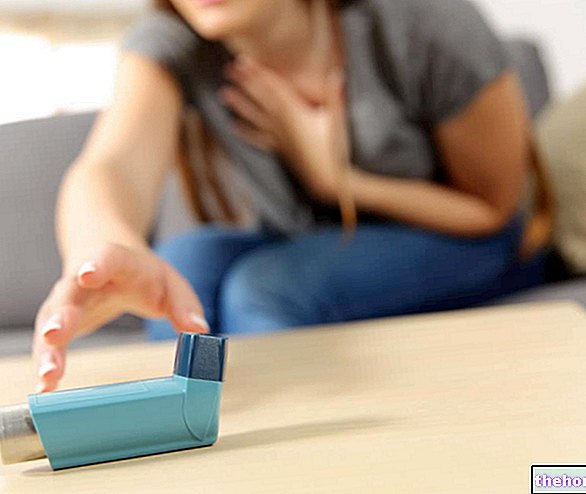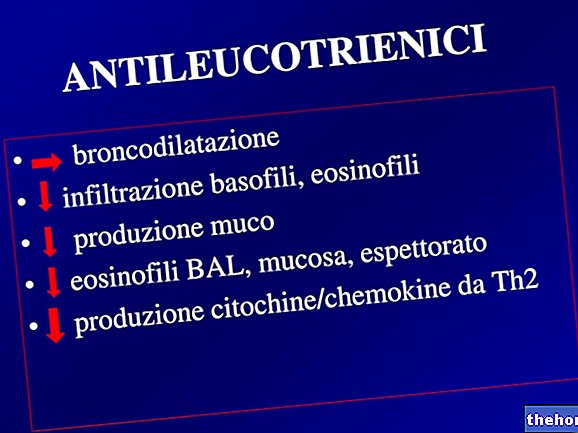Diagnosis
Diagnosing a "pulmonary embolism is difficult, for the following reasons:
- The disturbances caused are very similar to those caused by other morbid states.
- Classic diagnostic tests, such as chest x-rays or blood tests, are not sufficient to detect the presence of an occluding blood clot.
- The specific diagnostic tests for pulmonary embolism present a certain margin of risk, therefore they are carried out only if strictly necessary.

Figure: CT scan of a person with pulmonary embolism. Arrows indicate occluded vessels. From the site: wikipedia.org
During the diagnostic process, the first step is generally represented by the "physical examination, during which the doctor analyzes the signs and symptoms manifested by the patient and collects all the information relating to his state of health (clinical history), lifestyle (smoker or non-smoker), work activity etc.
Once the physical examination is over, we move on to the execution of more in-depth tests and specific examinations for pulmonary embolism.
BLOOD TESTS
Blood tests are aimed at quantifying D-dimer, a breakdown product that forms after the clotting process (the process that forms blood clots).
A high level of D-dimer is generally synonymous with a "higher than normal" coagulation activity and could therefore indicate that the patient is suffering from some thromboembolic disorder.
On the contrary, a normal D-dimer level excludes that there may be coagulation problems.
The measurement of the D-dimer is useful for identifying the general characteristics of the disease in progress (is it a thromboembolic disorder or not?), But it is not very specific: in fact, in the case of high values of D-dimer, it does not clarify what the causes are precise of this alteration.
CHEST X-RAY
Chest x-ray provides a clear image of the heart and lungs, but is not sufficient for pulmonary embolism.
Nevertheless, it is still carried out, in order to ensure that the symptoms accused by the patient are not due to pathological problems of any other nature (heart disease, pulmonary fibrosis, etc.).
ECODOPPLER
Useful in case of suspected deep vein thrombosis, the Doppler ultrasound allows to analyze in real time the anatomical and functional situation of the venous vessels of the legs.
It then clarifies the exact dynamics of the vascular blood flow (are there occlusions, narrowings or other anomalies?) And if there are any blood clots inside the vessels.
This is a completely bloodless procedure.
CT scan
CT scan (or computed axial tomography) can show any abnormalities of the pulmonary blood vessels. Therefore, it is a fairly reliable test.
This is a minimally invasive procedure, as it exposes the patient to a small dose of ionizing radiation.
ANALYSIS OF THE VENTILATION / PERFUSION RATIO: THE PULMONARY SCINTIGRAPHY
Lung scintigraphy (or V / Q scan or ventilo-perfusion scan) is divided into two parts or moments.
During the first part, the patient's ventilatory capacity is studied, making him inhale a radioactive gaseous substance, visible with a suitable instrument.
During the second part, however, pulmonary perfusion is analyzed (ie how the blood diffuses in the blood vessels that reach the lungs); for this purpose a radioactive substance is injected into a patient's vein, also visible with a suitable instrument.
At the end of the second part, the outcomes of each moment are compared: normal ventilation and "insufficient perfusion are usually unequivocal signs of a" pulmonary embolism
The main drawback of lung scintigraphy is represented by the use of radioactive materials.
LUNG ANGIOGRAPHY
Like any type of angiography, pulmonary angiography also allows you to view certain vascular districts and to study their morphology, course and any alterations.
The examination involves the insertion of a catheter into the venous system and the use of a contrast liquid visible on X-rays; therefore, it is quite invasive.
NUCLEAR MAGNETIC RESONANCE (NMR)
By creating magnetic fields, MRI provides a "detailed picture of internal organs, including blood vessels, without exposing the patient to harmful ionizing radiation.
Due to its cost, it is reserved for special cases, such as pregnant women and people unsuitable for scintigraphy.
Treatment
Premise: the following is the most commonly indicated therapy in case of pulmonary embolism due to deep vein thrombosis. In the rare cases in which the embolus is not given by a blood clot but by other materials (an air bubble, a lump of fat, a parasite, etc.) other types of treatment are necessary.
To treat a "pulmonary embolism, drug therapy is mainly used.
The most commonly used drugs are anticoagulants, such as heparin and warfarin; however, if needed, thrombolytic drugs could also be used.
If the patient is suffering from a "massive pulmonary embolism (therefore he is in an extremely serious condition), and if the aforementioned treatments have been ineffective, it may be necessary to resort to bloody and invasive interventions, such as" embolectomy and filtering (or filter) caval.
It is important to remember that treatment must be given promptly, as the life of a person with pulmonary embolism is seriously endangered.
ANTICOAGULANT THERAPY
Anticoagulant drugs have the power to slow down or stop the blood clotting process, but not to dissolve blood clots already present. The latter in fact dissolve spontaneously over time.
Usually, patients with pulmonary embolism are given:
- Low molecular weight heparin. In general, the use of low molecular weight heparin is foreseen only in the first days of therapy (for a maximum of 5-6 days). Administered intravenously in high doses, it can also be taken at home and not necessarily in a hospital setting. Today, low molecular weight heparin has taken the place of unfractionated heparin, as the latter requires regular monitoring, hence hospitalization.
- Warfarin. The intake of warfarin begins at the end of the heparin-based treatment. Its administration can last several months (at least three) or, if the circumstances require it, even a lifetime. The doses vary from person to person; for the right dosing, it may take several attempts and several blood tests to see the response of the blood.Once the appropriate amount of warfarin has been "found" for a given person, they should have a medical check-up every 30 days.
For the medicine to work in the best way, it is good to: adapt to the diet established by the doctor; limiting or even not drinking alcoholic beverages at all; always take the drug at the usual time; contact your doctor before taking any other medication; finally, avoid any pesticide.
- Fever
- Headache
- Bleeding problems, such as frequent rectal bleeding, blood in the urine and nosebleeds
- Frequent bleeding
- Headache
- Diarrhea
- Nausea and vomit
- Jaundice
THROMBOLYTIC THERAPY
Thrombolytic drugs have the ability to dissolve blood clots.
They are given to a patient with pulmonary embolism when it is necessary to speed up the dissolution of thrombi present in the blood vessels going to one of the two lungs.
Since thrombolytics have dangerous side effects (N.B: they predispose to hemorrhages, even at an intracranial level), their use is usually reserved for cases of massive pulmonary embolism; in fact, for more moderate cases, anticoagulant therapy is preferably used.
FILTER (OR FILTER) CAVALE.
Caval filtering, or caval filtering, is a somewhat invasive medical procedure.

Figure: vena cava filter for inferior vena cava. From the site: wikipedia.org
During its execution, the surgeon inserts in the neck (through the internal jugular vein) or in the upper part of the thigh (through the common femoral vein) a sort of filter that serves to sieve the "blood clots" present in the inferior vena cava, in the veins of the legs and in the right side of the heart. The object with which the filter is introduced and guided into the various venous vessels mentioned above is a catheter.
The practice of caval filtering is reserved for patients for whom treatment based on anticoagulants is not recommended.
LUNG EMBOLECTOMY
Pulmonary embolectomy is the surgery to remove the emboli (s) that occlude the pulmonary artery and / or its branches.
It is a very delicate procedure, not without side effects and still burdened by a high mortality rate. Its execution is reserved for extreme cases or for which drug therapy is considered useless (eg fat pulmonary embolism).
Prevention
If for some reason you are at risk of deep vein thrombosis, it is a good idea to:
- Take anticoagulants. A therapy based on anticoagulants is indicated for hospitalized individuals forced into infirmity, and for those who must observe a period of semi-immobility after surgery on the lower limbs.
-
Figure: compression stockings. From the site: alevalegs.com Wear elastic compression stockings. They are special stockings, specifically designed to promote blood circulation and reduce venous stasis in the lower limbs.
They are recommended for those who have undergone surgery or a bone fracture in the lower limbs and for those who often travel by plane or car.
As an alternative to compression stockings, there are also inflatable compression bandages. - Exercise at regular intervals, even for a few minutes. As in the previous case, this advice is particularly suitable for people who have just undergone surgery on their lower limbs and for those who travel a lot by plane or car.
Obviously, newly operated patients are recommended specific exercises, which do not jeopardize the post-operative recovery phase.
By following these recommendations, in addition to preventing deep vein thrombosis, you also protect yourself from its possible consequences, including pulmonary embolism.
Attention: today, to accelerate recovery times and to prevent the formation of blood clots, together with the consequences that may arise, doctors strongly advise against "excessive post-operative immobility."
OTHER TIPS FOR THOSE WHO TRAVEL A LOT BY PLANE OR BY CAR
Those who travel a lot by plane or by car are advised to:
- Take short walks, at regular intervals and for a few minutes. Generally, it is helpful to apply this advice once an hour.
- When sitting, perform special mobility exercises for the legs and hips (for example, raise the heel by pushing the toe to the ground). Also, it is strongly not recommended to cross your legs
- Drink water regularly, as dehydration of body tissues contributes to the formation of blood clots. The suggestion to drink regularly is especially indicated for those traveling by plane, inside which there is usually a "dry air that favors dehydration.
Prognosis
The prognosis depends on how much pulmonary blood perfusion is compromised (and therefore on the severity of the vascular obstruction), on the speed with which help is provided (if the situation is very serious) and on any pathologies associated with pulmonary embolism.
























-nelle-carni-di-maiale.jpg)




